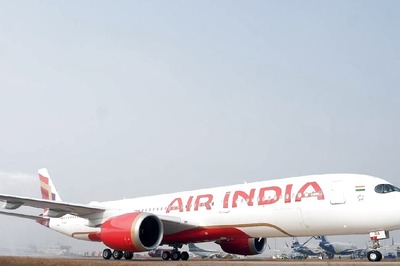
views
India has witnessed a total of 3,66,138 road accidents in 2020, which claimed 1,31,714 lives and caused 3, 48,279 injuries, according to the Ministry of Road Transport and Highways. With government’s keen focus on increasing road safety, Intel has been brought on board to start an initiative in India.
In June, during an event organised by Intel India, Union minister Nitin Gadkari said the central government aims to reduce road accident-related deaths by 50% by 2025 and to achieve the target implementation of Artificial Intelligence, as well as other available technologies will be required.
The tech behemoth, Intel, has been working on advancing research and innovation in AI for smart mobility for the past few years, aiming to help the country through a technology-powered solution.
Intel has collaborated with the International Institute of Information Technology, Hyderabad (IIIT-H) to build the world’s first open dataset of driving conditions in India.
With the open dataset, the company expects start-ups, academia, government, and industry will be able to collaborate on enabling AI-based solutions for road safety, enhanced infrastructure, and safer driving behaviours.
It is an undeniable fact that over the past few years the use of technology has helped the world overcome several challenges. So, News18 spoke to Kishore Ramisetty, Vice-President at Intel Foundry Services and General Manager, Vertical Solutions and Services Group, Intel, to find out more about how the tech giant has been using several technologies to enhance road safety situation in India.
The Starting Point
The concept for Intel® Onboard Fleet Services, which is an AI-powered fleet safety solution for commercial vehicles, began in October 2017 at the NITI Aayog Champions of Change event. Prime Minister Narendra Modi, who was present at the conference, explicitly challenged the team about how AI impacts the lives of ordinary people.
In an exclusive interview with News18, Ramisetty said, “The idea behind Onboard Fleet Services also drew significant insights from a seminal paper released in Switzerland that talked about how 6 out of 10 accidents that happen on the road can be avoided with the use of technology.”
According to Ramisetty, it highlighted that if an alert is given to the driver, let’s say, 2-3 seconds before an impending collision, he or she can avoid an accident by taking evasive action. While further explaining he said that it took a group of engineers based in India, who had a deeper understanding of the road, traffic and driving conditions in India, to develop the solution.
“The premise was to help the common man through a technology-powered solution, and we validated the solution rigorously for three years,” he noted.
Then in 2020, Intel India founded INAI, an applied AI research centre in conjunction with IIIT-H, the Public Health Foundation of India (PHFI), and the Government of Telangana, to use AI and build on current datasets to promote road safety research.
Intel India, INAI, IIIT-H, Central Road Research Institute (CSIR-CRRI), Mahindra & Mahindra, and Nagpur Municipal Corporation collaborated to launch Project iRASTE (intelligent Solutions for Road Safety via Technology and Engineering) in Nagpur in 2021.
It is noteworthy that this critical project uses AI and computer vision technologies to not only accomplish a 50% reduction in traffic accidents in Nagpur but also to build a template for Vision Zero for the country.
“This year, we organised the Safety Pioneers Conference, which was a conclave of pioneers committed to adopting advanced technologies such as AI to achieve India’s road safety goals,” said Ramisetty.
To further deepen the work towards enhancing road safety, the tech giant has also launched Project iRASTE in Telangana in collaboration with INAI, IIITH, Intel, Telangana State Road Transport Corporation (TSRTC), and Uber.
Use of Technology and Journey So Far
Ramisetty believes that the predictive insights created by AI and Advanced driver-assistance system (ADAS) technologies might avert accidents even before they occur, acting as a force multiplier to change road safety.
He explained that the technology breakthroughs such as AI, IoT, ADAS, and others are playing a transformative role in allowing smarter and safer vehicles, roads, and drivers. With the predictive capacity of AI, the technology and car ecosystem aspire to reimagine road safety, with assistance from the government, industry, and academia.
Furthermore, Ramisetty told News18 that ADAS provides a cost-effective solution to increase the safety of fleets and road users through collision avoidance alerts, as well as driver assessments and training that can significantly improve driver performance.
“When it comes to road safety in India, we are witnessing three separate aspects – safer vehicles, safer roads, and safer drivers. For each of these, we have deployed technologies such as AI, IoT, ML, Computer Vision, etc. In the safer roads category, we are implementing statistical analysis technologies/ML models that are utilized for identifying what we call grey spots and black spots,” he noted.
A black spot is a segment of a road where an accident caused a casualty and Intel calls it “a lagging indicator”.
As per Ramisetty, Intel is using AI and IoT technology to identify these spots and construct safer routes.
For example, once the accident-prone areas are identified, road engineers can work on rectifying flaws in the road’s design.
Ramisetty stated that for the goal of enabling safer drivers, it’s important to deliver then on-the-job training and targeted personalized coaching. This individualised teaching is made possible by AI approaches that can detect flaws in even the most experienced drivers’ driving techniques.
However, he also told News18 that they can predict a black spot before it falls into the category and it is called a grey spot. To identify these areas AI plays a major role.
The tech behemoth uses crowd-sourced techniques and analyses data from multiple vehicles having Intel technology that has gone over a particular road segment.
For example, if these vehicles provide comparable types of near miss notifications over that particular road section, such as alerts about a potential pedestrian collision or fender bender.
Ramisetty hopes that one day, “we will have a black and grey spots map of India at the click of a button, which will empower us to identify and take corrective action to convert all of them to white spots”.
It should be highlighted that Intel® Onboard Fleet Services, exclusively designed for Indian conditions, brings together numerous technologies in an all-encompassing package that scales to all kinds of vehicles and addresses the persisting challenges in India.
Ramisetty said: “I believe that we can scale the solution country-wide and it needs to be pursued in a systematic manner. The targeted outcome is to enable the innovation and research community to align with the government’s Vision Zero goal.”
In terms of collaboration, as of now, Intel has conducted pilot projects with state governments and road transportation organisations in Karnataka, Uttar Pradesh, and Kerala, among other places.
The organisation also has worked with subject area specialists such as the Central Road Research Institute (CRRI)-CSIR, which undertakes road design and engineering research and collaborated with businesses like Intangles to help the clients cut fuel waste and analyse vehicle health data.
Ramisetty confirmed that businesses like Sure Group Logistics, Sankyu India Logistics, and Allanasons have already deployed the Intel Onboard Fleet Services solution in industries such as HAZMAT/chemical products transit, Cold Chain, Third-Party Logistics (3PL), and Employee Transport.
Intel has established a dedicated R& D unit in Bengaluru that will control this product line and continue to introduce local innovations for the Indian fleet market.
Ramisetty believes that Intel’s long-standing commitment to road safety and initiatives will provide the auto industry with increased safety and operational efficiencies.
It should be noted that Intel spent years collecting over three million kilometres of data on Indian roads to develop the algorithms and tailor them to Indian conditions, which was a significant hurdle.
Its testing locations encompassed both urban and rural environments, as well as daylight and low-light scenarios. The solution’s results have been amazing, according to Ramisetty, with a nearly 70% boost in safe driving behaviours.
“Real accident reduction by 40-60%, overall efficiency loss reduction of up to 50%, and a 75% reduction in damage costs to the vehicle have been seen,” he added.
Citing the workflow, Ramisetty said while all real-time warning computations are performed locally on the devices, post-analysis is performed in the cloud, which additionally analyses the driver’s behaviour using data acquired over time. The advanced telematics includes vehicle health and fuel analytics, as well as a one-of-a-kind driver assessment and rating module.
He also noted that through tailored incentivisation and reward programmes, fleets may drastically minimise the risk of accidents and downtime while encouraging safer driving practices.
Vehicles with Intel’s Tech and Awareness
Intel’s technology is compatible with a wide range of cars, including vintage, commercial, and passenger fleets.
Under the solution, devices with cameras are installed on vehicles and they send real-time notifications to drivers and warn them of potential crashes.
These include outward-looking equipment that scans the road for potential crashes, as well as what we call a ‘driver monitoring device,’ which comprises of cameras facing the driver. This device also detects when the driver is tired or distracted, or if the driver is not wearing a seatbelt.
The second component of the solution is Intel’s cloud software which collects all of the data from these devices to perform an intelligent, offline analysis of these alarms. This study shows which drivers are aggressive, which are safe and which are neglectful.
Ramisetty said: “We do offline models and identify the driving characteristics of each of these vehicles, and thereafter, we give that data to the fleet managers, in the form of targeted personalised coaching, helping them become better drivers.”
“The cloud also utilises the same data and identifies grey and black spots. Combining all these real-time alerts makes vehicles become safer, and drivers more informed by giving targeted and personalised coaching,” he noted.
Intel anticipates the widespread use of ADAS in both commercial and passenger vehicles in India over the next few decades.
As of now, Intel’s customers have clocked over 9 million safe kilometres using the Intel Onboard Fleet services solution and the technology has generated about 8 million alerts during this time, which means that the company has analysed 8 million events for which the drivers have taken evasive action.
When Ramisetty was asked about the completion of this project, he said: “Until we eliminate every single road death and avoidable accident in India, I would consider this project a work in progress, and each of us – the academia, government, industry, and all the partners are in this together.”
“We are optimistic that in the coming future, more and more vehicles in India will be equipped with such technology, and with the government’s continued support, mandating them will help us achieve our goals successfully,” he added.
In the case of awareness among the people, Ramisetty believes that it has begun to rise and now it is up to corporations like Intel and other industry associations to help raise public awareness regarding tech-based road safety.
Read the Latest News and Breaking News here
















Comments
0 comment